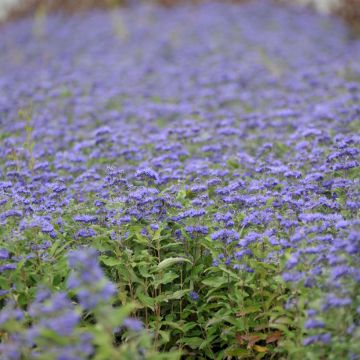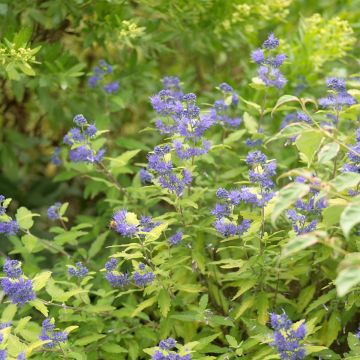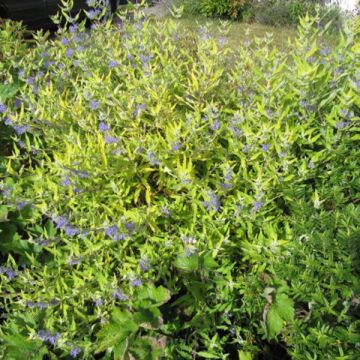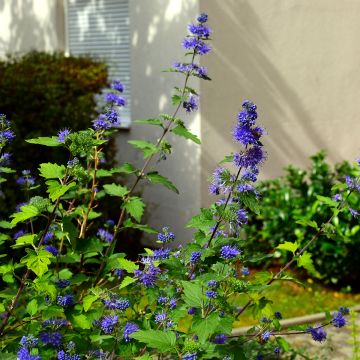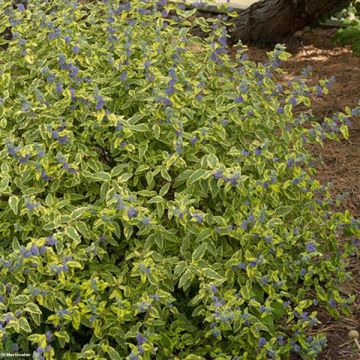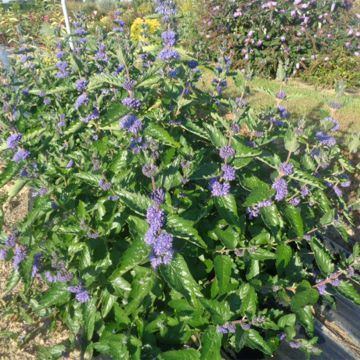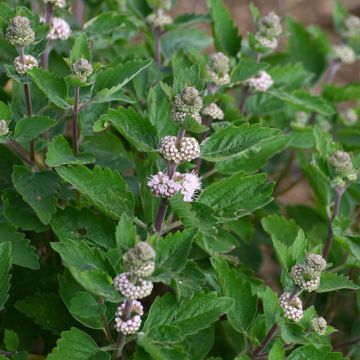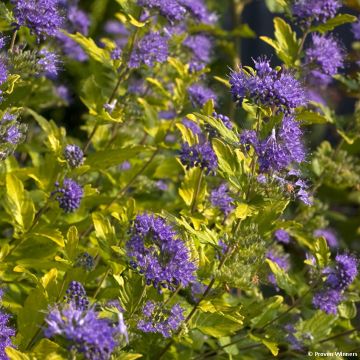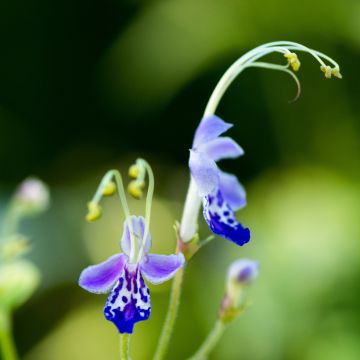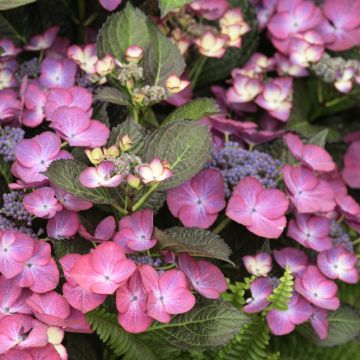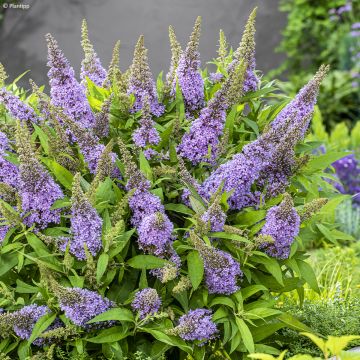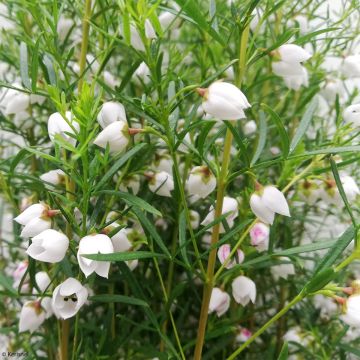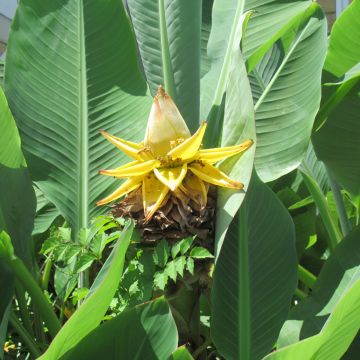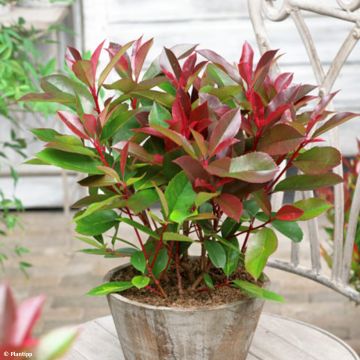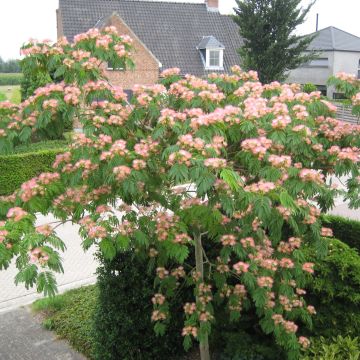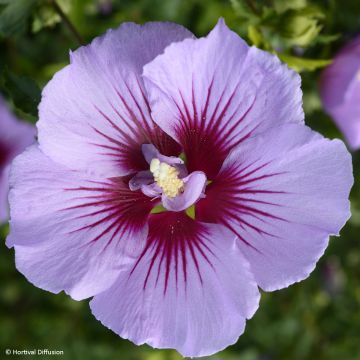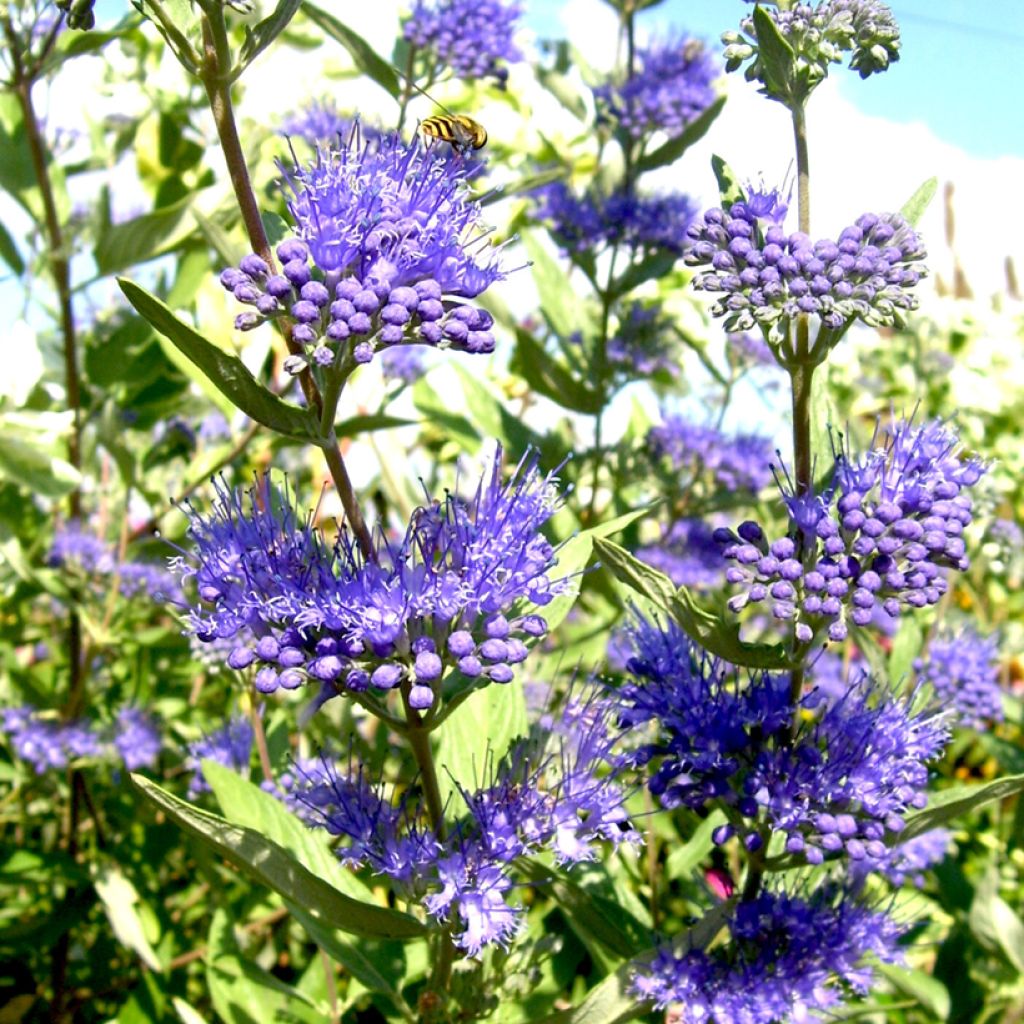

Caryopteris x clandonensis Camara Dark Blue - Spirée bleue
Caryopteris clandonensis Camara Dark Blue - Bluebeard
Caryopteris x clandonensis Camara Dark Blue ®
Bluebeard, Blue Spirea, Blue Mist Shrub
This item cannot be shipped to the selected country
Delivery charge from €6.90
More information
Delivery charge from €6.90
More information
Schedule delivery date,
and select date in basket
This plant carries a 24 months recovery warranty
More information
We guarantee the quality of our plants for a full growing cycle, and will replace at our expense any plant that fails to recover under normal climatic and planting conditions.
From €7.90 for pickup delivery and €6.90 for home delivery
Express home delivery from €8.90.

Does this plant fit my garden?
Set up your Plantfit profile →
Description
Caryopteris x clandonensis Camara® Dark Blue is a rather compact blue spirea selection with intense violet-blue flowering. From August to October, this small bush offers the gardener, as well as bees, numerous fluffy spikes. A late flowering, precious for adding colour and a source of food for pollinators at a time of year when they become rarer. Apart from its flowering, Caryopteris is appreciated for its aromatic foliage when crushed. It easily fits into borders, low hedges, and adapts to container gardening on a terrace. Not demanding, it is an excellent plant for well-drained soils, even limestone and fairly dry in summer.
Caryopteris x clandonensis Camara Dark Blue is one of the many hybrids obtained by crossing Caryopteris incana, an Asian bush known as 'Bluebeard', and Caryopteris mongolica, hardier, native to the colder regions of Mongolia and northern China. All belong to the Verbenaceae family. This cultivar 'Camara Dark Blue' forms a bushy shrub, with a bushy habit, about 1.20m (3ft 11in) high and 1m (3ft 4in) wide. It blooms in the second half of summer and until the beginning of autumn. Its inflorescences appear on the upper half of the current year's branches. They consist of countless tiny very dark blue-violet buds, gathered in large whorls or dense clusters, arranged in a staggered manner. The buds open into small intense violet-blue flowers, with prominent stamens. This flowering is particularly attractive to bees and nectar-feeding insects, and the bush is often visited by many colourful butterflies. The deciduous foliage, absent in winter, is a collection of thin and triangular leaves, 3 to 5cm (1.2 to 2in) long, aromatic, with irregularly toothed edges, arranged oppositely on straight stems. They have a dark green colour that appears more or less grey-silver depending on the dryness of the soil and the heat. When crushed, they release a resinous scent.
Caryopteris Camara Dark Blue is planted in the company of equally frugal summer-flowering shrubs : Russian sages (Perovskia) and shrub sages, shrub cinquefoils, St. John's worts, catmints, dwarf buddleias, landscaping roses... In a more natural dry garden style, plant it with grasses and shrubs with silver foliage such as Stipas and wormwoods. A very romantic scene can be created in late summer by combining Caryopteris with shrubby mallows ('Barnsley', 'Princesse de Ligne', 'Blue Bird'), shrubby wormwoods, and asters. A group of 3 bushes surrounding a pastel reblooming rose is a splendor in September, as their very different flowerings complement each other perfectly. It can also be planted in a nice pot on the terrace or balcony, in a sheltered location.
Plant habit
Flowering
Foliage
Botanical data
Caryopteris
x clandonensis
Camara Dark Blue ®
Verbenaceae
Bluebeard, Blue Spirea, Blue Mist Shrub
Cultivar or hybrid
Other Caryopteris
View all →Planting and care
Caryopteris are sun-loving plants that require well-drained soil. They can be planted early in the autumn or in the spring in colder regions, in a very sunny location and in a light, well-drained soil, even rocky or sandy, although fairly deep. While caryopteris is not sensitive to limestone, it will be more beautiful in humus-rich soil. Excessive waterlogged soil in winter will greatly affect its hardiness. In well-drained soil and a sheltered position, this plant can tolerate -15°C (5 °F) for short periods, for example, at the end of the night. In our cold regions, it is advisable to plant it against a south-facing wall. It is also worth noting that plants grown in pots are more susceptible to cold than those planted in open ground. Prune in late winter or very early spring to maintain a compact habit and promote the appearance of flowers on the young shoots of the year.
Planting period
Intended location
Care
-
, onOrder confirmed
Reply from on Promesse de fleurs
Summer-flowering shrubs
Haven't found what you were looking for?
Hardiness is the lowest winter temperature a plant can endure without suffering serious damage or even dying. However, hardiness is affected by location (a sheltered area, such as a patio), protection (winter cover) and soil type (hardiness is improved by well-drained soil).

Photo Sharing Terms & Conditions
In order to encourage gardeners to interact and share their experiences, Promesse de fleurs offers various media enabling content to be uploaded onto its Site - in particular via the ‘Photo sharing’ module.
The User agrees to refrain from:
- Posting any content that is illegal, prejudicial, insulting, racist, inciteful to hatred, revisionist, contrary to public decency, that infringes on privacy or on the privacy rights of third parties, in particular the publicity rights of persons and goods, intellectual property rights, or the right to privacy.
- Submitting content on behalf of a third party;
- Impersonate the identity of a third party and/or publish any personal information about a third party;
In general, the User undertakes to refrain from any unethical behaviour.
All Content (in particular text, comments, files, images, photos, videos, creative works, etc.), which may be subject to property or intellectual property rights, image or other private rights, shall remain the property of the User, subject to the limited rights granted by the terms of the licence granted by Promesse de fleurs as stated below. Users are at liberty to publish or not to publish such Content on the Site, notably via the ‘Photo Sharing’ facility, and accept that this Content shall be made public and freely accessible, notably on the Internet.
Users further acknowledge, undertake to have ,and guarantee that they hold all necessary rights and permissions to publish such material on the Site, in particular with regard to the legislation in force pertaining to any privacy, property, intellectual property, image, or contractual rights, or rights of any other nature. By publishing such Content on the Site, Users acknowledge accepting full liability as publishers of the Content within the meaning of the law, and grant Promesse de fleurs, free of charge, an inclusive, worldwide licence for the said Content for the entire duration of its publication, including all reproduction, representation, up/downloading, displaying, performing, transmission, and storage rights.
Users also grant permission for their name to be linked to the Content and accept that this link may not always be made available.
By engaging in posting material, Users consent to their Content becoming automatically accessible on the Internet, in particular on other sites and/or blogs and/or web pages of the Promesse de fleurs site, including in particular social pages and the Promesse de fleurs catalogue.
Users may secure the removal of entrusted content free of charge by issuing a simple request via our contact form.

































